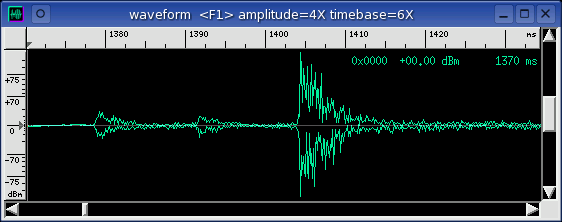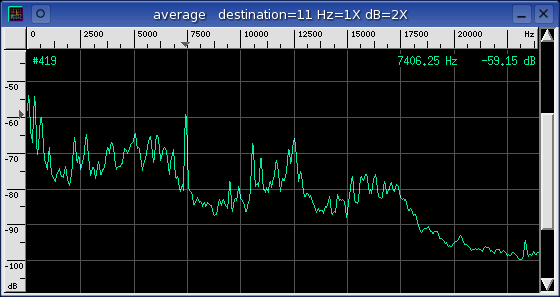We've got signal, but what the heck is it?
That's your mission. Analyze this bébé.

 download the audio file 15.wav.bz2
download the audio file 15.wav.bz2
hints :
-
No need to bunzip2 this file since baudline can automatically uncompress
bzip2 files.
-
Setup baudline to be a Web Browser helper application as described in the
FAQ.
-
Listen to the whole 11 second audio file because there are a number of
different clinks, clunks, and dings. Notice how the cadence changes.
-
Slow down the audio with the
Play Deck's speed control
and listen for sonic details that would otherwise be missed.
-
Use the
Color Aperture
window to focus and maximize the color resolution. An upper -20 dB and
lower -110 dB range is a good starting point.
-
Use the Kaiser or Gaussian
windows with a high beta
value to improve the time resolution in the spectrogram display.
-
Use the
periodicity bars to make
an accurate time measurement between the clicks. How constant and
repetitive is the mystery signal?
What is it?
 The source of this tick-tick-ta-tick mystery signal is an inexpensive windup
kitchen timer. It is a popular cooking aid that is used for timing tasks
like boiling eggs or pasta. The dial is turned by hand and has a range
from zero to 60 minutes.
The source of this tick-tick-ta-tick mystery signal is an inexpensive windup
kitchen timer. It is a popular cooking aid that is used for timing tasks
like boiling eggs or pasta. The dial is turned by hand and has a range
from zero to 60 minutes.
This particular kitchen timer makes a very complex mechanical sound that has
a number of interesting features. Let us first analyze the unique ticking
sounds and then measure the time keeping accuracy.
The strongest spectral pulse is the main timing tick and it is fairly regular
with a period of 0.218 seconds (~4.6 Hz). Occasionally the cadence
changes and an extra beat is inserted or a clunk is heard. Suprisingly
this slop does not adversely affect the periodicity, the clock rhythm keeps on
ticking. Zooming into the spectrogram timebase using the Gaussian
window with a beta value
of 6 will improve time domain resolution and allow extra spectral details
to become visible.

Two faint clicks precede the main tick by 0.012 and 0.024 seconds. These
pre-clicks are believed to be some sort of latch and release mechanism that is
required for the firing of the main click. A fourth faint click is also
visible that trails the main click by 0.085 seconds. The timing of these
pre and post events are very consistent from click to click.

If the SNR
is good then the same delta 0.012 second measurement result can be accomplished
using the waveform window.
The clicks have a broadband spectral structure which is the common response for
impulse (impact) signals. The wideband click pulses have spectral energy
that extend up to the 24 kHz Nyquist frequency limit which suggests that
significant energy may exist past that point, possibly to 100+ kHz.

The average spectrum display
above is a copy-n-paste accumulation of the bell-like tones that ring after the
main impact click. Many tones are visible; 7400 Hz, 10500 Hz, and 12500
Hz being the strongest. The 7400 Hz tone has a decay time of about 0.085
seconds which signifies that the ringing is being damped by the action of the
fourth click. These non-harmonically related ringing tones are the source
of the characteristic metallic sound.
Baudline's
periodicity bars were used
to make highly accurate timing measurements. The periodicity of the click
spacing changes from 0.218 seconds at the start of the .wav file to 0.216
seconds at the end which means that the speed of the ticking is increasing
as the clock winds down. This delta of 0.002 seconds is a change of -9000
PPM over a duration of 11 seconds
for a -800 PPM/second drift. This kitchen timer could be classified as
an extremely poor time keeping device.
|


![]()